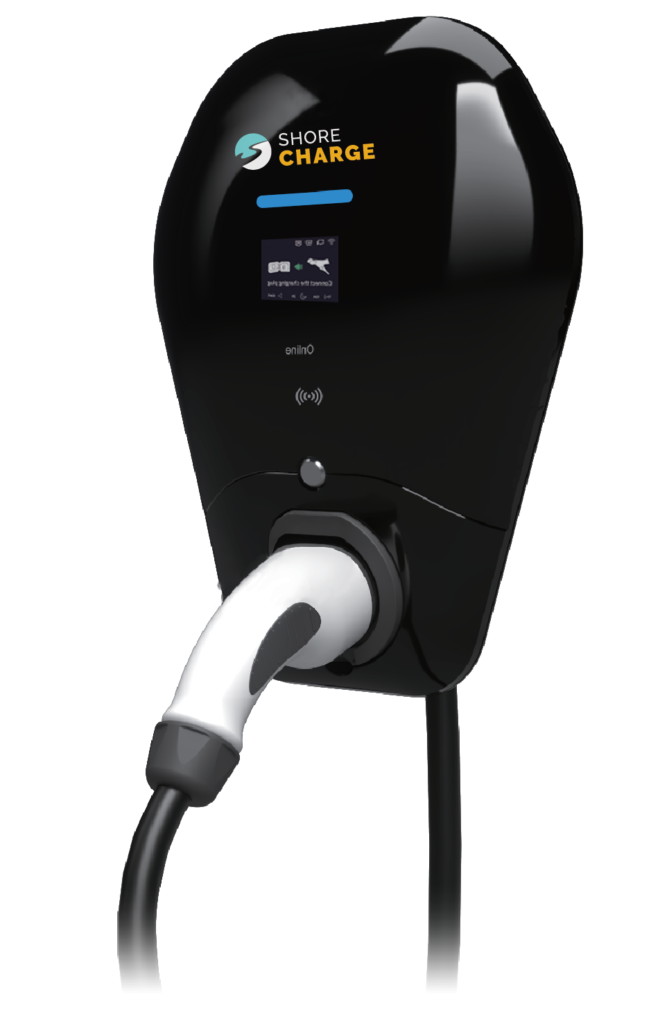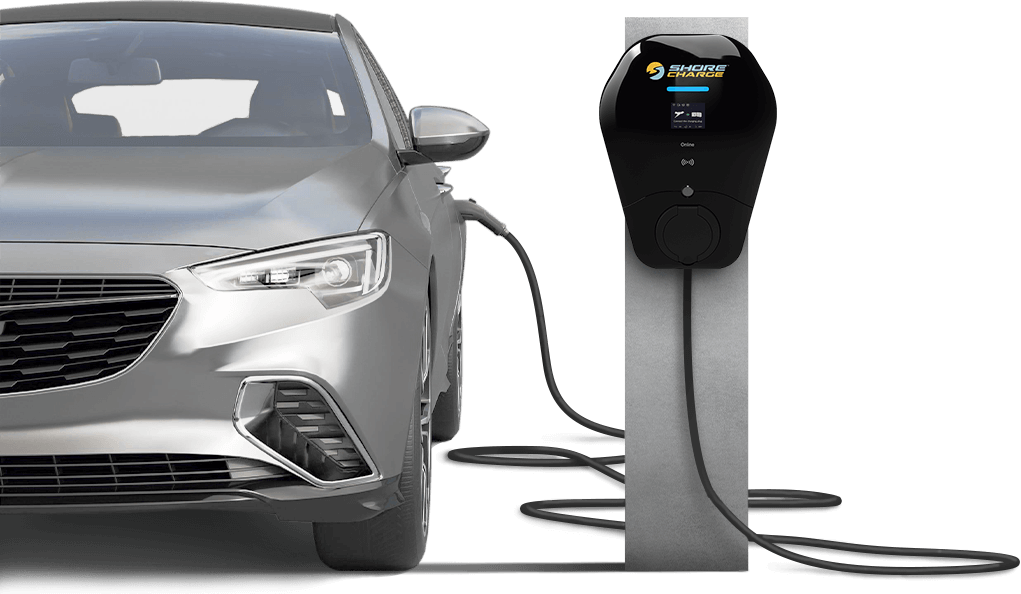Electric vehicles are powered by electric batteries instead of gasoline. This means they need to recharge at a charging station—not refuel at a pump—and they don’t emit harmful CO2 into the environment.
The technology behind electric vehicles is constantly improving, which means they are more affordable and can drive further between charging sessions than ever before. More people are trusting them when they venture away from home, such as for vacations or business trips.
What’s missing is the infrastructure to support them, which is where STRs come in. As more travelers adopt EVs, short-term rental owners like you can provide convenient places for them to rest and recharge.
One of the biggest challenges to driving an electric vehicle is ensuring you have reliable charging accessibility.
In a nation without a widespread EV charging infrastructure, EV drivers can be understandably anxious about being able to charge their vehicles when needed—especially when they venture away from home and outside of their routines.
When they travel, EV drivers typically choose to stay in locations where they know they can easily charge their cars so they don’t end up stranded.
Also, where a gasoline-powered vehicle can refuel in a matter of minutes, an electric vehicle takes longer to charge, sometimes up to several hours. For many EV-driving travelers, this can translate to wasting precious vacation hours sitting at a public charging station.
So, many will search for STRs that provide an on-site charging station. Or, they bring their own Level 1 chargers with them, using the STR’s electricity and leaving the owner with a higher electric bill.
Like any technology that uses a rechargeable battery, electric vehicles need to be plugged in to recharge when their juice is low.
Electric vehicle drivers use charging stations to charge their cars as needed. Many have private chargers at their homes. They can also sometimes find public access charging stations where they work, at some gas stations, and in some public parking lots.
When using a public charging station, the EV driver pays via a credit card or smartphone app. The driver then plugs in the vehicle using a compatible charging cable (many stations contain several types) and waits for the station to alert them that the session is complete.
Charging speeds are classified into 3 different levels:

Learn more about how long electric vehicles take to charge here.
At ShoreCharge, we want to make EV charging even more convenient than refueling gas-powered vehicles. So, we are partnering with the experts of providing hospitable lodging for the weary traveler: short-term rental owners.
By adding ShoreCharge EV chargers to their properties, STRs attract this growing demographic of EV drivers by relieving their range anxiety. Guests rest easy knowing they can recharge on-site and fully enjoy everything their vacation has to offer.
Plus, ShoreCharge offers benefits for property owners that other EV charging solutions don’t.
ShoreCharge strives to make the process seamless for short-term rental property owners.
Your partnership with ShoreCharge includes:
Plus, we partner with licensed local electricians for charger installation and maintenance because we understand the importance of supporting local communities.

Installing an EV charger on your short-term rental property offers several benefits, including…
Having an electric vehicle charger on your property can help attract more renters to your listing and fill up those gaps in your booking calendar. Plus, ShoreCharge EV chargers provide hassle-free maintenance and a boost to your rental income.
More travelers are purchasing or renting EVs, which means they are looking for STRs that offer convenient charging capabilities. If guests do not see an EV charger amenity in your listing, they could bring their own Level 1 charger or choose a different property altogether. When guests use their own chargers, they are essentially charging their vehicles on your dime. Plus, Level 1 chargers are less efficient and can trip breakers and GFCIs on your property, leading to expensive nuisance calls.
Talk to a ShoreCharge representative today about how a ShoreCharge EV charger could bring greater value to your property.
If you’re looking for a way to boost your rental income and attract more renters to your property without having to add something else to your maintenance list, the ShoreCharge EV charger is the solution for you.
By providing a convenient and powerful EV charging amenity, you will attract EV drivers who often struggle to find charging stations while traveling. EV-driving renters pay for charging sessions. ShoreCharge covers the maintenance and shares the revenue with you!
With the ShoreCharge EV charger, homeowners receive an owner’s code or RFID card that allows for free owner charging.
When you partner with ShoreCharge, you pay for the EV charging equipment and its installation. The exact costs depend on your unique situation and are calculated after a team member assesses the requirements of your property.
There are no monthly subscription fees to use the ShoreCharge EV charger. Once the charger is installed, each EV-driving guest pays for their charging sessions, and we share the revenue with you each month.
Each ShoreCharge EV charger has a unique QR code located on the unit. Your guests scan the code with their phone and then securely pay by Apple Pay, Google Pay, or credit card.
Since our EV charges are connected to your home’s electricity, you will see a slight increase in your electrical bill. However, the exact amount depends on several factors. The Department of Energy has calculated the average monthly costs for EV drivers who regularly charge their vehicles at home.
As a ShoreCharge STR partner, the charging fees your guests pay will be shared with you to cover the increased electrical costs—and then some—in the vast majority of situations.
There are two types of electric vehicles: battery electric vehicles (BEV) or plug-in hybrid electric vehicles (PHEV). How long it takes an EV to charge depends on the type of vehicle, as well as the type of charger that is used.
For example, if you were to charge a Tesla Model 3 (BEV) from 10% to 90% on a…
Some public access EV charging stations are free, but many charge a fee per kilowatt hour of usage. The cost per kWh is often higher at public stations than private ones, which is part of the reason EV drivers prefer to charge their vehicles at home.
Using a ShoreCharge EV charger comes with unique advantages. You will boost your rental income through our shared revenue program without having to pay out of pocket for charger maintenance. Plus, we offer strategic marketing guidance and free customer support to each property owner who partners with us.
At the end of each month, ShoreCharge provides you with a detailed statement outlining the power consumed by your guests and your share of the revenue. Then, we initiate an ACH transaction, depositing your share of the revenue directly into your bank account, eliminating inconveniences and delays often associated with traditional payment methods.
ShoreCharge charging equipment comes with a J1772 gun and a NACS/J3400/Tesla EV adapter, making it compatible with almost all EV cars in the United States.
Our ShoreCharge EV chargers are monitored 24/7 with an encrypted 4G LTE connection. This means you do not need to have WiFi to use our chargers—an added benefit for those out-of-the-way destinations.
ShoreCharge provides free continuous monitoring of your EV charger through 4G LTE connectivity. This means we will often spot a problem before your guests do and send out a team member to quickly resolve the issue. Plus, our customer support service is happy to address any questions or concerns.
Many online travel booking (OTB) websites now allow travelers to filter their search results according to amenities like EV charging accessibility.
Without a dedicated Level 2 charging station on your property, a guest could choose to bring and use their own Level 1 charger. This means that you will have no way of being reimbursed for the extra electricity they use. Plus, there is a risk they could trip a circuit or GFCI in your electrical panel, leading to expensive service calls.